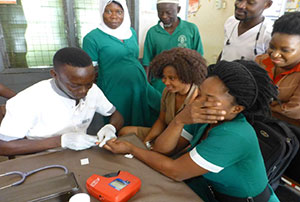
Preface
Anaemia is an urgent public health problem that affects children and women throughout the life course and results in a high burden of morbidity and mortality. Caused by multiple factors, anaemia requires a package of mitigating interventions. The main approaches to managing anaemia include malaria prevention, diagnosis, and treatment; helminth prevention and control; and nutrition-related interventions. Nutrition-based approaches include modifying food processing and preparation techniques to ensure optimal availability and absorption; promoting the consumption of adequate amounts of iron-rich foods; increasing the bioavailability of iron-rich foods by supporting farmers in growing and marketing iron-rich crops; mass fortification of food; and biofortification of foods. These strategies are preferable in the long-term; interim interventions are often needed to meet the recommended dietary intake requirements of populations that are not reached using nutrition-based approaches.Point-of use fortification with micronutrient powders or iron tablets or syrups for children can increase iron levels and effectively reduce anaemia. Furthermore, given the high iron requirements during pregnancy, iron–folic acid (IFA) supplementation has long been recommended for all pregnant women, and more recently for all women of reproductive age. Delayed cord clamping is a non-dietary intervention to increase the total body iron content of infants at birth. Interventions having an indirect impact are water, sanitation, and hygiene (WASH) interventions, family planning, and infant and young child feeding practices.
The effectiveness of the interventions depends on accurate and reliable diagnosis of anaemia. The Ghana Health Service has distributed HemoCue® point-of-care devices to measure haemoglobin concentration at the health facility level, to assess the prevalence of anaemia. The objective of this manual is to define and explain anaemia, its causes and effects, and methods for diagnosis of—also to outline the procedure for measuring haemoglobin concentration with the HemoCue Hb 301 device. The target audience for this manual is staff from health facilities who have been selected to become master trainers. These selected personnel will travel to the districts to provide training to the health staff in the subcentres and Community-Based Health Planning and Services (CHPS) zones.
Overview
Welcome to the HemoCue trainer’s guide. This manual will:
- Describe the objectives of the training
- Describe the nature (underlying assumptions) of the training package
- Outline the training to be provided
- Describe the process of measuring haemoglobin concentrations using the HemoCue Hb 301 system
- Provide information about each lesson/section in this half-day training
Objectives of the Training Programme
The HemoCue training programme is designed to ensure that staff in health centres and CHPS zones have the knowledge and skills needed to diagnose anaemia at health facilities and in the community. This manual is part of a broader integrated anaemia training package designed revitalise how anaemia is prevented and treated in Ghana.
The objectives of this manual are to:
- Provide facilitators with sufficient guidance and materials to support their training of health workers on the use of the HemoCue to diagnose anaemia
- Provide guidance to facilitators to enable them to train health staff in ensuring the supply of essential commodities to sustain the use of the HemoCue device
- Provide materials that allow facilitators to assess the impact of the training through questionnaires as well as observation
Nature of the Training
This half-day training programme combines didactic lecture, demonstration of process, and self-assessment. The half-day session ensures that the health facility staff will know how to carry out haemoglobin assessment with the HemoCue Hb 301 device. However, it will take practice and repetition for the staff to become familiar with the use of the device. Trainers should highlight the fact that these trainings DO NOT end with the training session, but rather, the training is the start of a process that will involve follow-up and support from the trainers.
How to Use This Manual
This manual is an aid to carrying out the training workshop. It is divided into six timed lessons and one post-training assessment session for a total duration of three hours. Each of the lessons deals with a subject related to the diagnosis of anaemia using the HemoCue Hb 301 device.
Each lesson has instructions on facilitation. Some of the lessons use a corresponding PowerPoint presentation to convey information. These presentations are designed to be printed out as hard copies. The information in the PowerPoint slides is presented in this manual’s lesson text in a form that can be used by the facilitator.
Participants in the training will be given a participant’s manual to which they can refer for the salient points of the training.
To view the full training document, please download it above.